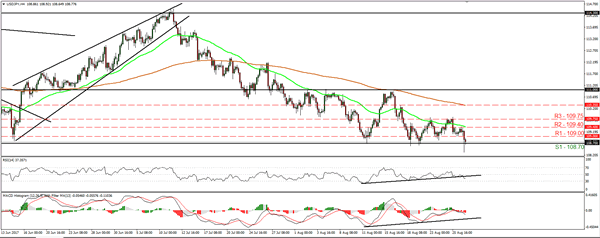Overnight, North Korea fired a missile that violated Japanese airspace and fell approximately 1180km east of Japan’s Hokkaido Island. According to media reports, this act may have been intended to show that an attack on the US territory of Guam is possible. North Korea has conducted several missile tests lately, but a rocket has not flown over Japan since 2009. This marks a clear escalation of the latest geopolitical tensions in the region, and likely comes as a response to the military drill that the US and South Korea have been conducting recently.
The market response was a classic risk-off reaction, with investors immediately turning to safe haven assets. Gold, JPY, and CHF all rallied on the news, while riskier assets such as the AUD and Japanese stocks tumbled. We believe that this negative sentiment may spill over into European and US equity markets, the indices of which could open with negative gaps today.
Moving forward, we expect market action to be very much headline-driven. A lot may depend on how the US, Japan and South Korea respond to this aggression. Japanese PM Abe already stated that ‘We must immediately hold an emergency meeting at the United Nations, and further strengthen pressure against North Korea’. Such a diplomatic response would likely be the ‘soft’ approach, and may thus carry little market impact. On the other hand, if we see an escalation in rhetoric, such as more ‘fire and fury’ comments or some form of action from the NATO countries, this risk-off sentiment could linger and we may see the overnight price action continue.
USD/JPY traded lower overnight following the news. The pair dipped briefly below 108.70 (S1), but quickly rebounded to trade fractionally above it. The rate is back within the range between 108.70 (S1) and 111.00 and thus, the short-term outlook remains flat in our view. If the situation escalates further, we expect the bears to drive the battle back below 108.70 (S1), a move that could turn the bias to the downside this time, and initially aim for the 108.00 (S2) support.
Switching to the daily chart, we see that the pair is trading within a broader range between 108.70 (S1) and 114.40. This keeps the medium-term outlook flat as well, but a clear dip below 108.70 (S1) could be the first sign for larger downside extensions, perhaps towards the long-term upside support line, taken from the low of the 24th of June 2016.
Gold surged yesterday, breaking above the key psychological barrier of 1300 (S2). Subsequently, the metal gapped further up after North Korea fired a missile over Japan, to hit resistance at 1325 (R1) before retreating somewhat. The 1300 (S2) zone acted as the upper bound of the wide range the metal has been trading within since the 31st of January, between that hurdle and the 1200 territory. As such, its clearing make us confident that the outlook may have turned somewhat positive. We would expect a move above 1325 (R1) to set the stage for extensions toward our next resistance of 1340 (R2). Having said that, given that the latest rally appears overextended, we would stay careful of a possible retreat before the bulls decide to take charge again. A dip below 1313 (S1) may confirm the case and is possible to open the way for a test near the 1300 (S2) zone as a support this time.
The economic calendar is light today:
We only get second-tier economic indicators: The UK nationwide house price index for August, Canada’s PPI for July, the US S&P/Case-Shiller house price index for June, and the nation’s Conference Board consumer confidence index for August are all due out. We have only one speaker on the agenda: Chicago Fed President Charles Evans. He is a voting FOMC member this year, and usually maintains a cautious stance on policy matters. Speaking in early August, Evans said that inflation would have to accelerate for him to support an interest-rate hike at the end of the year. Given that the latest US CPI prints were disappointing, we doubt he will deviate much from his latest dovish remarks.
USD/JPY

Support: 108.70 (S1), 108.00 (S2), 107.40 (S3)
Resistance: 109.00 (R1), 109.40 (R2), 109.75 (R3)
Gold

Support: 1313 (S1), 1300 (S2), 1292 (S3)
Resistance: 1325 (R1), 1340 (R2), 1352 (R3)












